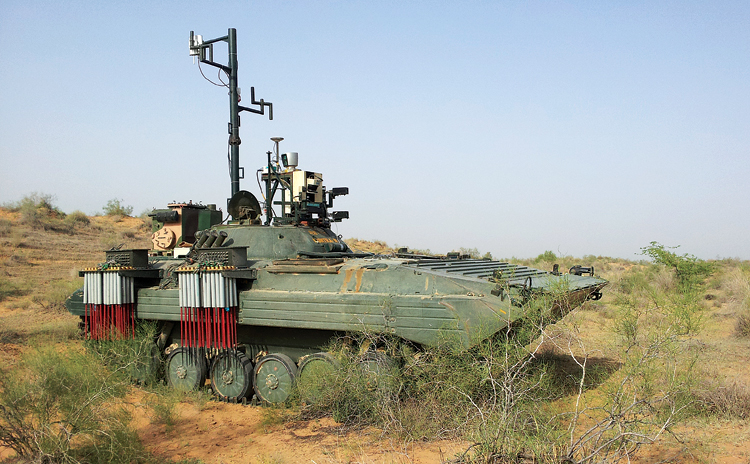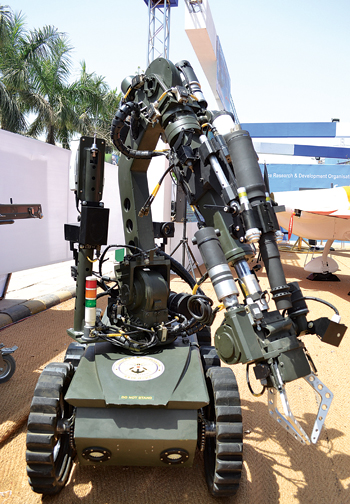INDIAN ARMED FORCES CHIEFS ON OUR RELENTLESS AND FOCUSED PUBLISHING EFFORTS

The insightful articles, inspiring narrations and analytical perspectives presented by the Editorial Team, establish an alluring connect with the reader. My compliments and best wishes to SP Guide Publications.

"Over the past 60 years, the growth of SP Guide Publications has mirrored the rising stature of Indian Navy. Its well-researched and informative magazines on Defence and Aerospace sector have served to shape an educated opinion of our military personnel, policy makers and the public alike. I wish SP's Publication team continued success, fair winds and following seas in all future endeavour!"

Since, its inception in 1964, SP Guide Publications has consistently demonstrated commitment to high-quality journalism in the aerospace and defence sectors, earning a well-deserved reputation as Asia's largest media house in this domain. I wish SP Guide Publications continued success in its pursuit of excellence.
- All about HAMMER Smart Precision Guided Weapon in India — “BEL-Safran Collaboration”
- US to sell $93 million precision artillery, Javelin and Excalibur projectiles to India
- US to sell $93 million precision artillery, Javelin and Excalibur projectiles to India
- India, Germany deepen defence ties as High Defence Committee charts ambitious plan
- True strategic autonomy will come only when our code is as indigenous as our hardware: Rajnath Singh
- India-Israel Joint Working Group Meeting on defence cooperation to boost technology sharing and co-development
- G20 Summit: A Sign of Global Fracture
UGVs for Army
Indian Army Design Bureau (ADB) had sought tailor-made technology for the Army for inducting tactical UGVs for close quarters surveillance and combat

Reports of December 8, 2021, indicate that the Indian Army is planning to induct unmanned ground vehicles. The report quotes an unnamed official saying, “In the quest for induction of niche technologies into the Army, one of the key areas identified is UGVs. While unmanned aerial vehicles (UAVs) have proliferated, the development of UGVs has been slow. Towards this end, the Army conducted a ‘UGV Experiment’ to bring together companies and startups who have developed prototypes for testing at the Babina field firing ranges from December 9 to 14. Over 30 different types of UGVs will be showcased by the developers and tested by Army personnel.”
Army has already inducted aerial drones, beginning with the ‘Bharat’ surveillance drones after the Chinese aggression in Eastern Ladakh during 2020. It was also brought out in these columns earlier that the Nagpur-based private defence manufacturer, Economic Explosives Limited (EEL) has developed indigenous drones and loitering munitions system which were shown on November 15 to the then Chief of Defence Staff, General Bipin Rawat, and that user trials are planned in the coming months for different versions of the drone and loitering munitions as well as the anti-drone systems also developed by EEL.
The UGVs are employed where there is a probability of excessive fatigue or danger of casualties to personnel, as also where it is inexpedient to involve human presence
An entry in the ‘Compendium of Problem Statements-2020’ by the Indian Army Design Bureau (ADB) had sought tailormade technology for the Army for inducting tactical UGVs for close quarters surveillance and combat, originated in consonance with the UGV Employment Philosophy that has been formulated for the Army.
DRDO Projects
The Defence Research & Development Organisation (DRDO) began working on UGVs in early 1990s at its following entities; Bengaluru-based Centre for Artificial Intelligence & Robotics (CAIR), Chennai-based Combat Vehicles Research & Development Establishment (CVRDE), Pune-based Research & Development Establishment Engineers (R&DE{E}), and Ahmednagar-based Vehicle Research & Development Establishment (VRDE). It was decided that 5-50 kg UGVs would be developed by CAIR, 1-3 tonne UGVs by R&DE (E), wheeled vehicles up to 5-tonne by VRDE and tracked vehicles beyond 5-tonne by CVRDE. In due course of time, the following DRDO projects have come up:
- Project MUNTRA by CVRDE. Taken up in 2007, this project was to convert 3 x BMP-II armoured personnel carriers (APCs) into tele-operated/autonomous UGVs for unmanned missions with payloads of surveillance, chemical, biological, radiological and nuclear (CBRN) reconnaissance, mine detection and mine marking missions. Three separate UGVs were to be developed - one for each of the payload missions and one base vehicle; MUNTRA-S for surveillance missions, MUNTRA-N for CBRN reconnaissance missions and MUNTRA-M for mine detection/marking missions. The base vehicle is MUNTRA-B, from which the UGVs are tele-operated through wireless communication links, which are also used to relay video footage and other sensor data. The surveillance suite of MUNTRA-S was trial evaluated by the Central Industrial Security Force (CISF) in January 2017.
- Project DAKSH by CAIR. Daksh is a remotely operated mini-UGV for recovery of unexploded bombs. It can negotiate some hurdles in an urban setting. It can also be utilised to survey and monitor nuclear and chemical contamination levels. Daksh can either be controlled by fibreoptic communication over 100m distance or by wireless over 500m line of sight distance with a master control station (MCS). 90 per cent of its components are reportedly indigenous. The Army has contracted 20 of these.
- Tele-Operated Dozer by CVRDE. In September 2017, CVRDE undertook development of a tele-operated BD50 Dozer, based on the in-service BD50 Bull Dozer for preserving human lives during landslides and snow clearance operations in high altitude locations. This was in response to requirements projected by the Army. This UGV was trial evaluated by the Army in mountainous terrain and observations raised are in the process of being addressed by the CVRDE.
- Joint Development with Japan. According to news reports of 2018, a joint project for development of UGVs was agreed to by the DRDO in collaboration with Acquisition, Technology and Logistical Agency (ATLA) of Japan.


Indigenous Private Sector
A host of indigenous private firms, startups and students are engaged in development of UGVs. These include companies like Bharat Forge, Torus Robotics Private Limited, ECA Group and the like. Bharat Forge showcased a UGV during the Army Technology (ARTECH) Seminar-2018, which was subsequently trial evaluated by the Army and some modifications have been suggested.
The Army conducted a ‘UGV Experiment’ to bring together companies and startups who have developed prototypes for testing at field firing ranges from December 9 to 14
Torus Robotics has developed the a Mobile Autonomous Robotic System (MARS) UGV for the DRDO in consultation with the Army Design Bureau (ADB), to detect, identify and dispose of Improvised Explosive Devices (IEDs) from a remote distance of one km. The UGV can also be used for reconnaissance and information gathering. MARS was displayed at Aero India 2021 held in February 2021. The startup has also signed a memorandum of understanding (MoU) to develop an upgraded version of MARS in collaboration with Bharat Earth Movers Ltd (BEML) which will be capable of load carriage equivalent to 10 soldiers in high altitude terrain.
What the Army is Looking For
The UGVs are employed where there is a probability of excessive fatigue or danger of casualties to personnel, as also where it is inexpedient to involve human presence. The Army is looking for UGVs that are capable of: being operated remotely-controlled as well as in autonomous modes; agile and manoeuvrable in different terrains ranging from deserts and plains to high altitude areas including the border with China occupied Tibet (COT), and; equipped with remotely-controlled medium machine guns, laser range finders, night vision devices for target acquisition and the like.
The Army’s ‘UGV Experiment’ should give the best available UGV products by the DRDO as well as by the private sector. In the long run, the indigenous UGV technologies are expected to move from the tele-operated UGVs to completely autonomous networkcentric UGVs capable of undertaking complex battlefield tasks.





